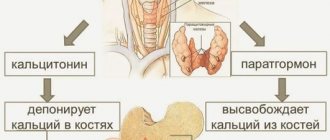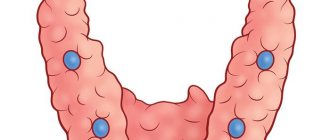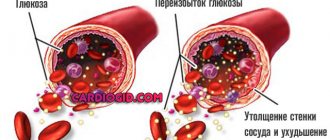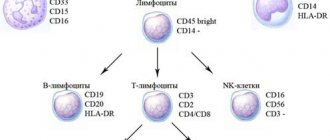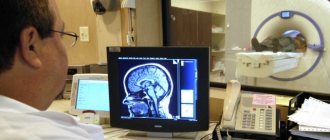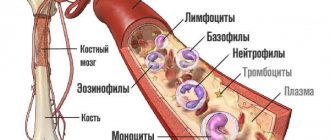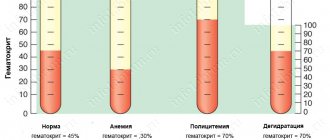A woman’s hormonal background is one of the main criteria for her health. And estradiol is considered the most “female” hormone. Any deviations from the norm of this substance affect the regularity of the cycle, the ability to conceive and the general condition of the body.
Menstrual cycle
A woman's ovaries produce sex hormones: progesterone, estrogens and androgens. The group of estrogens includes three substances:
- estrone (E1)
- estradiol (E2)
- estriol (E3)
The ovaries, in turn, are controlled “from above”, through the interaction of the brain with the endocrine organs.
The normal menstrual cycle consists of the follicular phase, ovulation and luteal phase. From the first day of menstruation, follicles develop in the ovaries, the largest of which becomes dominant and produces estrogen.
Under the influence of this hormone, ovulation occurs on the 14th day of the cycle, the egg is released, and the follicle turns into the corpus luteum. It secretes estrogens and progesterone. If pregnancy does not occur, then the corpus luteum gradually disappears, hormonal levels drop, resulting in menstruation.
Estrogens during pregnancy
The corpus luteum of pregnancy, formed after successful conception, begins to actively synthesize progesterone and estrogens. Until 6 weeks, estradiol predominates in the mother’s blood, then estrone levels increase slightly. In later stages, the main source of these hormones is the fetal adrenal glands. Thus, the level of estrogen gradually rises throughout 40 weeks, and, having reached its maximum level, perhaps plays one of the main roles at the onset of labor.
Estradiol: main tasks in the female body
Estradiol is essential for women for the normal functioning of both the reproductive system and the entire body. For example, estradiol helps to activate the contractile function of the myocardium, strengthen vascular walls and reduce cholesterol levels in the blood.
This hormone also increases the tone of the smooth muscle fibers of the intestinal wall and bladder, which improves the functioning of these organs.
In addition to smooth muscles, estradiol has a positive effect on the activity of skeletal muscles, promoting their regular contraction and relaxation. Thus, the endurance and resistance to stress of the human body increases, and the body becomes elastic.
Estradiol is rightly called the hormone of good mood, because thanks to it we have positive emotions. Depressive states are often observed in individuals with estradiol levels below normal.
In addition to a good mood, estradiol helps women be beautiful and sexy. This is explained by the fact that this hormone allows the appearance of secondary sexual characteristics, such as round breasts, steep hips, thin waist, smooth skin, soft voice, etc. The significant importance of estradiol in the formation of libido is also noted.
Numerous medical studies have shown that estradiol helps maintain a fit body shape and weight. For example, in women of menopausal age, as a result of a decrease in the level of estradiol in the blood, the problem of excess weight and brittle bones often arises.
Estradiol plays an important role in creating favorable conditions for fertilization, loosening the endometrium so that successful implantation of the zygote occurs.
What is the hormone responsible for?
Estradiol is one of the most active female sex hormones. The substance belongs to estrogens. Estradiol is produced in the ovaries in women or in the testes in men. In expectant mothers in early pregnancy, it is synthesized by the placenta.
In women, estradiol is responsible for reproductive health.
It is thanks to its norm (in the table) that at the appropriate age she has rounded shapes, beautiful skin and hair, a high and soft voice. Doctors have not thoroughly studied the role of estradiol for men, but they agree that its deficiency leads to diseases of the reproductive and skeletal systems.
The figure shows a diagram of estradiol.
Functions of estradiol in the body:
- The appearance of secondary sexual characteristics: pubic hair, breasts, fat deposits on the hips.
- Improving the condition of skin and hair.
- Formation of female libido.
- Follicle formation during the menstrual cycle.
- Preparing a woman's body to bear a child.
- Stimulates blood circulation and uterine growth during pregnancy.
- Regulation of the nervous system.
- Removing “dangerous” cholesterol from the body.
- Improving the condition of bone tissue.
- Strengthening blood vessels and myocardial walls.
- Maintaining bladder tone.
- Improving blood clotting.
Estradiol and the menstrual cycle: relationship
Estradiol is synthesized and released into the blood throughout the entire monthly cycle, only in different quantities. Its synthesis occurs in the ovaries, adrenal cortex and adipose tissue, and during pregnancy - in the fetal place.
During the follicular phase of the monthly cycle, estradiol is produced in minimal quantities, under the influence of follicle-stimulating and luteinizing hormones. Before the ovulatory phase, the amount of the hormone increases three times, after which it decreases, reaching a minimum level before menstruation.
Estradiol can be converted into estrone and estriol throughout the monthly cycle.
Also, the level of estradiol in women changes with every hour of the day. The largest amount of the hormone is synthesized between 15 and 18 hours of the day, and the smallest - between 24 and 2 am.
How to increase with the help of medications
Medications are used when there is a serious decrease in estrogol levels. It is recommended to take them in combination with vitamin and mineral complexes.
The following drugs can be used to increase the hormone:
- Estradiol valerate (dipropionate). Synthetic analogue of the hormone. The drug is prescribed not only when the level of natural estradiol decreases, but also to improve well-being before menopause, as well as after removal of the ovaries.
- Premarin. The drug contains hormones from the estrogen group. It is recommended to use it to reduce the symptoms of menopause and diseases associated with it. The medicine is also used to correct hormonal levels in diseases of the female reproductive system.
- Hemafemin. It is a dietary supplement that can be used to improve a woman’s well-being with hormonal disorders and severe psycho-emotional stress. As a prophylactic agent, it can be prescribed when estrogen levels are reduced to prevent early aging of the woman’s body.
- Proginova. The drug is a source of synthetic estrodiol. It is recommended to use it to prevent thinning of bone tissue during menopause and after removal of the ovaries.
Factors affecting the level of estradiol in the body
Once again, I would like to say that the norms of the hormone estradiol in women can change under the influence of various factors, namely:
- phase of the menstrual cycle;
- age;
- pregnancy;
- changes in climatic conditions;
- fluctuations in body weight;
- harmful environmental factors
- psycho-emotional shock;
- bad habits (drinking alcohol, smoking);
- taking medications.
Each of these facts, as a rule, causes fluctuations in the level of estradiol in the blood within the acceptable range.
Preparations with estradiol
Today, contraceptives based on estradiol or analogues are widely used. They are a good protection against unplanned conception due to their effect on the inner surface of the uterus. The egg cannot attach to the damaged uterine epithelium and begin to develop. But such contraception has a significant disadvantage: over time, the layer of the uterus atrophies, and the chances of pregnancy decrease. The use of drugs with estradiol can be dangerous, so you should not use them without the advice of a doctor.
With prolonged use of drugs with estradiol, the following symptoms may appear:
- intense headaches and dizziness;
- liver dysfunction with all the ensuing consequences;
- mood swings, irritability, nervousness;
- weight gain;
- vaginal bleeding in different phases of the cycle;
- sand and stones in the gall bladder.
Estradiol is widely used to treat underdevelopment of the genital organs and absence of menstruation. The hormone estradiol also helps with osteoporosis and excessive sweating.
Diseases treated with estradiol:
- hypoplasia;
- amenorrhea;
- infections and inflammations of the genital organs with frequent relapses.
Contraindications are:
- liver diseases;
- pregnancy;
- lactation;
- sickle cell anemia;
- otosclerosis;
- jaundice;
- herpes;
- gallbladder disease;
- thrombophlebitis;
- hypercalcemia.
Consultation with a doctor is required if the patient suffers from diabetes, epilepsy, heart or kidney failure, endometriosis, migraines, bronchial asthma, porphyria, tumors, mastopathy, connective tissue diseases. Estradiol can reduce glucose tolerance in patients with diabetes.
Blood test for estradiol
In a blood test, the level of this hormone is usually displayed in picograms per milliliter (pc/ml), but this indicator can also be expressed in picomoles per liter (pmol/l).
A blood test for estradiol is prescribed by specialists in such cases as:
- hormonal imbalance in the body, as a result of which the monthly cycle is disrupted;
- lack of ovulation;
- infertility;
- disruption of the sex glands;
- periodic uterine bleeding not associated with the menstrual cycle;
- pronounced manifestations of premenstrual syndrome;
- malfunction of the pituitary gland;
- polycystic ovary syndrome;
- fragility of bone tissue;
- ovarian neoplasms;
- adrenal neoplasms;
- preparation for in vitro fertilization.
Blood for testing for estradiol is taken strictly from the 4th to 6th day of the menstrual cycle. The control analysis is carried out in the period from 20 to 21 days of the cycle.
In order for the result of a blood test for estradiol to be as objective as possible, when preparing for the study, you must adhere to the following recommendations:
- 2-3 days before the study it is not recommended to transfer;
- 24 hours before blood sampling, limit physical and mental stress;
- Avoid having sex 24 hours before;
- 24 hours before blood sampling, smoking and drinking alcohol are prohibited;
- If you are taking any medications, notify the doctor who ordered the tests. In this case, temporary discontinuation of the drugs may be considered, since they may distort the results of the study for estradiol;
- The last meal should be no later than 12 hours before blood sampling. The analysis is carried out strictly on an empty stomach.
The optimal time for blood sampling for research is 8-11 am. Blood is taken from the cubital vein in an amount of 5-10 ml.
Waiting for the result of a blood test for estradiol can take three to seven days. In emergency cases, the result can be ready five hours after blood collection.
How to conduct research: tests
Blood testing for estradiol is always done on an empty stomach. Drinking tea and coffee without sugar, any drinks and juices is not allowed. If you are very thirsty, you can quench it with a small amount of clean water.
Preparation and delivery of the test for estradiol:
- You need to stop smoking for a few days.
- On the eve of the analysis, it is recommended not to engage in physical activity and refrain from playing any sports.
- Usually the test is carried out a week after the start of menstruation, but in some cases the doctor may prescribe other dates.
- If necessary, the analysis is repeated after 20 days.
- If a woman uses oral contraceptives, they should not be used on the day of the test, and the name and type of the drug should be reported to the laboratory assistant.
- A few days before the test, you need to observe sexual rest.
- It is recommended to take tests at the same time, preferably from 8 to 10 am.
During routine diagnostics, analysis results are prepared within 3 to 5 days. In an emergency situation, most often when there is a threat of miscarriage, the analysis can be ready within 24 hours. Ways to increase estradiol: diet and traditional medicine Herbal treatment of low estradiol is a safe and useful way to stabilize hormonal levels.
It is recommended to use the following means:
- Sage decoction. It is necessary to use the product from the first days of menstruation - at this time, sage is most beneficial for the female body. To prepare the decoction you need 1 tbsp. l. dry herbs, pour boiled hot water (1 glass) and leave for 20-25 minutes. The resulting liquid should be divided into 3 doses and consumed throughout the day.
- Red brush decoction. Pour a spoonful of red brush into a large mug of hot water. The broth is simmered in a water bath for several minutes, avoiding boiling. After this, the liquid should infuse for at least 1 hour.
- Infusion of rapeseed. Add about 1-1.5 tbsp per cup of hot water. l. common rape herb. Making and using the infusion is similar to the recipe using sage.
When preparing infusions and decoctions, do not use boiling water. After boiling, it must be left for several minutes until the temperature drops to 80 degrees.
You can also increase estradiol with the help of nutrition.
Standards for women by age (table) can be raised using the following products:
- flax-seed;
- olive oil;
- beans, including soybeans;
- tomatoes;
- cabbage;
- beet;
- apricots;
- tangerines;
- melon;
- parsley;
- tuna;
- brown rice;
- coffee;
- bitter chocolate.
Estradiol: normal in women
Table of estradiol norms in women by age.
| Woman's age | Estradiol norm, pg/ml |
| from birth to 1 year | 0 |
| from 2 to 3 years | from 0 to 22 |
| from 4 to 6 years | 22 |
| from 7 to 12-14 years | from 22 to 30 |
| from 12-14 to 55 years old | from 57 to 480 |
| over 55 years old | from 18 to 85 |
In addition to age, estradiol in the blood is affected by the phases of the menstrual cycle and pregnancy.
The norms of estradiol for the phases of the menstrual cycle are as follows.
- Follicular phase – from 68 to 1265 pmol/l.
- Ovulatory phase – from 130 to 1657 pmol/l.
- Corpus luteum phase – from 90 to 860 pmol/l.
During menopause, the amount of estradiol in the blood is reduced and averages 50 pcs/ml.
The norm of estradiol during pregnancy depends on the trimester, namely:
- in the first – from 210 to 6300 pc/ml;
- in the second – from 800 to 19000 pcs/ml;
- in the third – from 11800 to 37000 pc/ml.
Phytorecipes to increase estradiol
You can compensate for the lack of female hormone by consuming decoctions based on hops, sage, linden leaves, boron uterus and other herbs. To get the maximum benefit from the drug, you need to prepare the drink correctly. Dry plant preparations should be brewed not with boiling water, but with hot liquid (temperature –70-90°). If the recipe calls for boiling, place the bowl of herbs and hot water in a water bath.
When taking products prepared from herbal preparations, you should not expect a quick effect. To obtain results, time must pass during which phytoestrogen accumulates in the body.
Estradiol and testosterone: ratio
When assessing the results of a study on a sex hormonal panel, experts evaluate not only the absolute values of estradiol, but also its ratio with other hormones (prolactin, progesterone, testosterone).
The most significant when assessing women's health is the ratio of estradiol and testosterone, which normally should be 10:1, but also an acceptable ratio of 7:1. That is, the normal functioning of the female body is indicated by the result of hormones, in which the level of estradiol is 7-10 times higher than testosterone.
In cases where the level of estradiol is only five times higher than testosterone or less, then such a condition is called hyperandrogenemia in medicine.
Symptoms of hyperandrogenemia may include the following:
- menstrual irregularities;
- acne;
- causeless weight gain;
- changing the timbre of the voice from high to low.
There is also a condition called hypoandrogenemia, when the level of estradiol is much higher than testosterone (12 times or more). The following symptoms are characteristic of hypoadrogenemia:
- severity of manifestations of premenstrual syndrome;
- heavy periods;
- irritability;
- the appearance of spotting in the middle of the cycle.
The most dangerous consequence of hyperandrogenemia is diabetes mellitus, and hypoandrogenemia is tumors of the ovaries and uterus.
Popular products for youth and sexuality
One of the ways to increase the hormone in the body is a balanced diet. The diet includes foods containing estradiol. The menu is designed so that it contains a minimum of carbohydrates and fats. The emphasis should be on sources of fiber and protein.
Phytoestrogens are found in legumes. Therefore, 2-3 times a week there should be dishes made from peas, lentils, soybeans, and beans on the table. A whole storehouse of plant substances, which are identical in composition to estradiols, is present in flax seeds. Recommended products for women's health include: beets, parsley, carrots, cabbage, melons, raspberries, tangerines.
Top 10 products for women's health | |
| Vegetable origin | Animal origin |
| Grape | Kefir |
| Apricots | Cottage cheese |
| Tomatoes | Full fat milk |
| Flax seeds | Cheese |
| Pumpkin seeds | Sour cream |
Do not indiscriminately consume all foods rich in estradiol. It is enough to include valuable ingredients in different dishes in doses or eat them in their pure form. Periodically it is necessary to monitor the dynamics of the increase in the hormone, since its excess is just as dangerous as its deficiency.
Estradiol during pregnancy
Let us note once again that estradiol levels during pregnancy are higher than in non-pregnant women.
In the early stages of pregnancy, the amount of estradiol in the blood of the expectant mother corresponds to normal levels, but as the uterus enlarges, it gradually increases.
The highest level of this hormone is observed in the third trimester of pregnancy. 5-6 days after birth, estradiol levels gradually return to normal.
The role of estradiol during pregnancy is that it promotes normal fetal development and prevents miscarriage or premature birth. This hormone also strengthens the walls of blood vessels in the birth canal to avoid ruptures during childbirth.
Level up, reasons
The following pathologies and diseases can increase the amount of estradiol in the body:
- Severe liver diseases, including cirrhosis.
- Diseases and disorders of the thyroid gland.
- Inflammatory diseases of the ovaries, uterus, adrenal glands. In cases of infectious diseases of the female reproductive system, temporary hormone surges are possible.
- Malignant tumors.
- Testicular tumors (in men).
- Obesity.
- Alcoholism.
Disease does not always lead to increased levels of the hormone. High estradiol is observed with the use of drugs for hormonal treatment, as well as with poor nutrition and abuse of traditional therapy.
Estradiol during menopause
Menopause in women occurs at the age of 45-55 years, although it happens earlier.
During menopause, women experience a decline in reproductive function and a decrease in the level of estrogen, in particular estradiol, which is manifested by disorders of the sexual sphere and the functioning of all body systems.
Among the menopausal symptoms, the most common are:
- menstrual irregularities followed by cessation of menstruation;
- tides;
- urinary incontinence;
- decreased sex drive;
- dryness of the vaginal mucosa;
- emotional lability;
- bone fragility.
Also, during menopause, the appearance of hypertension, atherosclerotic vascular lesions and other diseases of the cardiovascular system is possible.
When assessing the result of a blood test for estradiol in a woman who is in menopause, the specialist takes into account the following factors:
- how old is the woman;
- what is the duration of menopause;
- presence of health complaints;
- the presence of diseases of the cardiovascular, nervous, digestive, endocrine and other systems.
During menopause, all women experience low levels of estradiol in the blood.
How to reduce using medications
It is more difficult to reduce estrodiol than to increase it.
If there is an excess of female sex hormone, it is recommended to use the following medications:
- Tamoxifen. The drug is used to treat cancer and precancerous conditions of the breast in women. Regular use of the drug in a lower dose prescribed by a doctor leads to a decrease in estrogen levels.
- Orgametril. Contains the synthetic hormone gestogen, an antagonist of female sex hormones. Negatively affects ovulation and prevents conception. Used for contraception, delaying menstruation and for heavy bleeding from the uterus.
- Mastodinon. A herbal preparation that is used for the treatment and prevention of mastopathy. The homeopathic remedy is excellent for women whose hormone levels are slightly elevated and lead to painful sensations in the chest and PMS.
- Indiol. Used to stabilize hormonal balance. Can be used in the initial stages of cancer treatment. The course of treatment for elevated estrodiol is from 3 months to six months.
Causes, symptoms and treatment of low estradiol
The most common cause of low estradiol levels is taking medications, including oral hormonal contraceptives and chemotherapy drugs. Most often, such an adverse reaction occurs with the following drugs:
- Dexamethasone;
- Pravastatin;
- Mifepreston;
- Cimetedin;
- Danazol;
- Nafarelin.
Also, a decrease in the amount of estradiol in the blood can be caused by a high-carbohydrate or low-fat diet, vegetarianism, alcohol abuse and menopause. Among the diseases that most often lead to a decrease in this indicator, it is necessary to highlight polycystic ovary syndrome and chronic inflammatory diseases of the reproductive system.
Symptoms of low estradiol in the blood are the following:
- acne on the face;
- dry skin;
- constant feeling of fatigue;
- feeling of coldness in the upper and lower extremities;
- swelling;
- baldness;
- the appearance of hair on the face, chest, abdomen and buttocks;
- disruption of the menstrual cycle;
- anovulatory cycle;
- infertility;
- tendency to diarrhea;
- soreness of the mammary glands;
- insomnia or drowsiness;
- irritability;
- decreased sex drive.
Diagnosis and treatment of estradiol deficiency in women is carried out by a gynecologist together with an endocrinologist.
Treatment for low blood estradiol in women of childbearing age is hormone replacement therapy. Estrofem, Proginova, Estradiol and Estraderm TTS 25 are highly effective in this case.
Self-medication is strictly prohibited, since an inadequate dose or duration of treatment with drugs that contain estradiol threatens irreversible consequences, such as a complete cessation of the synthesis of this hormone in the body.
In addition to drug therapy, experts recommend following a diet with a predominance of protein foods and intensifying your sex life.
Symptoms with increased concentrations of hormones
The following are signs of high estradiol levels:
- a large number of blackheads, acne;
- excess weight while following a diet;
- frequent swelling;
- severe fatigue, disturbance of emotional background;
- menstruation disorders, bleeding, pain;
- the appearance of fat deposits on the buttocks and chest, hair loss on the face and pubis, decreased libido;
- pain in the mammary gland;
- constant feeling of numbness and coldness in the fingers and toes;
- abdominal pain, digestive disorders;
- sleep disorders;
- convulsions.
What hormones affect reproductive function?
In order for a woman of reproductive age to have regular menstruation and for the egg to mature, so that she can conceive, carry and give birth to a child, and subsequently successfully feed him with breast milk, it is necessary that the body produces certain hormones in sufficient quantities. These hormones include:
- FSH or follicle stimulating hormone;
- LH (luteinizing hormone);
- prolactin;
- estradiol;
- anti-Mullerian hormone (AMH).
Treatment
All prescriptions and subsequent treatment of hormonal disorders should be carried out exclusively by a specialist.
Important: self-prescription of hormonal drugs is strictly prohibited.
In cases where hormonal imbalance in women is associated with stress, vitamin deficiencies, poor nutrition, etc., the use of sedatives and herbal preparations with phytoestrogens is recommended (herbs such as oregano, licorice, mint, etc. are indicated for low levels hormones), balanced and adequate nutrition, adequate sleep and rest, taking folic acid, Omega-3® (fish oil, flaxseed oil, etc.), as well as multivitamin complexes (A, E, B, etc. .).
By cycle phases
The phase of the cycle affects the level of estradiol as follows: in the follicular and luteinizing phases it is low, in the preovulatory period it begins to increase.
| Cycle phase | Norm in nmol/l | Norm in pg/ml |
| Follicular | 0,14-0,7 | 38,1-190,4 |
| Luteal | 0,17-1,1 | 46,2-299,2 |
| Ovulation | 0,34-1,8 | 92,5-489,6 |
| Menopause | 0,01-0,13 | 0,01-35,4 |
Estradiol levels also change at different times of the day, especially during the menstrual cycle. The maximum data occurs at 15-18 hours, the minimum - from 24 to 2 am.
Prevention
You can avoid problems with estradiol by eliminating all “male” habits from your life: smoking, drinking alcoholic beverages, drug addiction, drug-induced tone enhancement. Most drugs to stimulate sexual function suppress the ovaries.
Leading an incorrect lifestyle, being carried away by bad habits and dubious sexual contacts, a woman actually ceases to be a woman. Estradiol, which makes girls sophisticated and soft, is reduced. As a result, abnormal growth of body hair begins, the voice becomes rougher, and the skin dries out. The woman's gait and movements become abrupt. A severe deficiency of the hormone can even interrupt menstruation.
